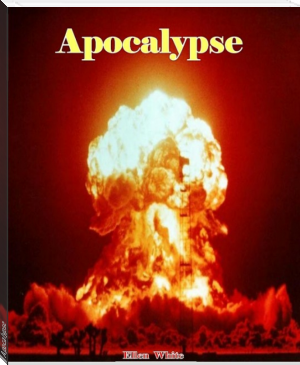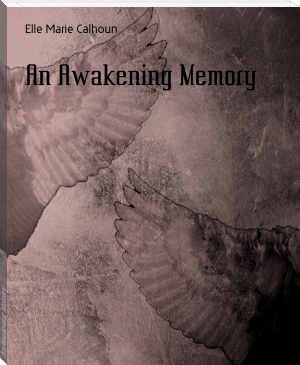Apocalypse, Ellen G. White [best e book reader for android TXT] 📗

- Author: Ellen G. White
Book online «Apocalypse, Ellen G. White [best e book reader for android TXT] 📗». Author Ellen G. White
Such was the service performed "unto the example and shadow of heavenly things." And what was done in type in the ministration of the earthly sanctuary is done in reality in the ministration of the heavenly sanctuary. After His ascension our Saviour began His work as our high priest. Says Paul: "Christ is not entered into the holy places made with hands, which are the figures of the true; but into heaven itself, now to appear in the presence of God for us." Hebrews 9:24. The ministration of the priest throughout the year in the first apartment of the sanctuary, "within the veil" which formed the door and separated the holy place from the outer court, represents the work of ministration upon which Christ entered at His ascension. It was the work of the priest in the daily ministration to present before God the blood of the sin offering, also the incense which ascended with the prayers of Israel. So did Christ plead His blood before the Father in behalf of sinners, and present before Him also, with the precious fragrance of His own righteousness, the prayers of penitent believers. Such was the work of ministration in the first apartment of the sanctuary in heaven.
Thither the faith of Christ's disciples followed Him as He ascended from their sight. Here their hopes centreed, "which hope we have," said Paul, "as an anchor of the soul, both sure and steadfast, and which entereth into that within the veil; whither the forerunner is for us entered, even Jesus, made an high priest forever." "Neither by the blood of goats and calves, but by His own blood He entered in once into the holy place, having obtained eternal redemption for us." Hebrews 6:19, 20; 9:12.
For eighteen centuries, this work of ministration continued in the first apartment of the sanctuary. The blood of Christ, pleaded in behalf of penitent believers, secured their pardon and acceptance with the Father, yet their sins still remained upon the books of record. As in the typical service there was a work of atonement at the close of the year, so before Christ's work for the redemption of men is completed there is a work of atonement for the removal of sin from the sanctuary. This is the service which began when the 2300 days ended. At that time, as foretold by Daniel the prophet, our High Priest entered the most holy, to perform the last division of His solemn work--to cleanse the sanctuary.
As anciently the sins of the people were by faith placed upon the sin offering and through its blood transferred, in figure, to the earthly sanctuary, so in the new covenant the sins of the repentant are by faith placed upon Christ and transferred, in fact, to the heavenly sanctuary. And as the typical cleansing of the earthly was accomplished by the removal of the sins by which it had been polluted, so the actual cleansing of the heavenly is to be accomplished by the removal, or blotting out, of the sins which are there recorded. But before this can be accomplished, there must be an examination of the books of record to determine who, through repentance of sin and faith in Christ, are entitled to the benefits of His atonement. The cleansing of the sanctuary therefore involves a work of investigation--a work of judgment. This work must be performed prior to the coming of Christ to redeem His people; for when He comes, His reward is with Him to give to every man according to his works. Revelation 22:12. Thus those who followed in the light of the prophetic word saw that, instead of coming to the earth at the termination of the 2300 days in 1844, Christ then entered the most holy place of the heavenly sanctuary to perform the closing work of atonement preparatory to His coming.
It was seen, also, that while the sin offering pointed to Christ as a sacrifice, and the high priest represented Christ as a mediator, the scapegoat typified Satan, the author of sin, upon whom the sins of the truly penitent will finally be placed. When the high priest, by virtue of the blood of the sin offering, removed the sins from the sanctuary, he placed them upon the scapegoat. When Christ, by virtue of His own blood, removes the sins of His people from the heavenly sanctuary at the close of His ministration, He will place them upon Satan, who, in the execution of the judgment, must bear the final penalty. The scapegoat was sent away into a land not inhabited, never to come again into the congregation of Israel. So will Satan be forever banished from the presence of God and His people, and he will be blotted from existence in the final destruction of sin and sinners.
The subject of the sanctuary was the key which unlocked the mystery of the disappointment of 1844. It opened to view a complete system of truth, connected and harmonious, showing that God's hand had directed the great advent movement and revealing present duty as it brought to light the position and work of His people. As the disciples of Jesus after the terrible night of their anguish and disappointment were "glad when they saw the Lord," so did those now rejoice who had looked in faith for His second coming. They had expected Him to appear in glory to give reward to His servants. As their hopes were disappointed, they had lost sight of Jesus, and with Mary at the sepulcher they cried: "They have taken away my Lord, and I know not where they have laid Him." Now in the holy of holies they again beheld Him, their compassionate High Priest, soon to appear as their king and deliverer. Light from the sanctuary illumined the past, the present, and the future. They knew that God had led them by His unerring providence. Though, like the first disciples, they themselves had failed to understand the message which they bore, yet it had been in every respect correct. In proclaiming it they had fulfilled the purpose of God, and their labour had not been in vain in the Lord. Begotten "again unto a lively hope," they rejoiced "with joy unspeakable and full of glory."
Both the prophecy of Daniel 8:14, "Unto two thousand and three hundred days; then shall the sanctuary be cleansed," and the first angel's message, "Fear God, and give glory to Him; for the hour of His judgment is come," pointed to Christ's ministration in the most holy place, to the investigative judgment, and not to the coming of Christ for the redemption of His people and the destruction of the wicked. The mistake had not been in the reckoning of the prophetic periods, but in the event to take place at the end of the 2300 days. Through this error the believers had suffered disappointment, yet all that was foretold by the prophecy, and all that they had any Scripture warrant to expect, had been accomplished. At the very time when they were lamenting the failure of their hopes, the event had taken place which was foretold by the message, and which must be fulfilled before the Lord could appear to give reward to His servants.
Christ had come, not to the earth, as they expected, but, as foreshadowed in the type, to the most holy place of the temple of God in heaven. He is represented by the prophet Daniel as coming at this time to the Ancient of Days: "I saw in the night visions, and, behold, one like the Son of man came with the clouds of heaven, and came"--not to the earth, but--"to the Ancient of Days, and they brought Him near before Him." Daniel 7:13.
This coming is foretold also by the prophet Malachi: "The Lord, whom ye seek, shall suddenly come to His temple, even the Messenger of the covenant, whom ye delight in: behold, He shall come, saith the Lord of hosts." Malachi 3:1. The coming of the Lord to His temple was sudden, unexpected, to His people. They were not looking to Him there . They expected Him to come to earth, "in flaming fire taking vengeance on them that know not God, and that obey not the gospel." 2 Thessalonians 1:8. But the people were not yet ready to meet their Lord. There was still a work of preparation to be accomplished for them. Light was to be given, directing their minds to the temple of God in heaven; and as they should by faith follow their High Priest in His ministration there, new duties would be revealed. Another message of warning and instruction was to be given to the church.
Says the prophet: "Who may abide the day of His coming? and who shall stand when He appeareth? for He is like a refiner's fire, and like fullers' soap: and He shall sit as a refiner and purifier of silver: and He shall purify the sons of Levi, and purge them as gold and silver, that they may offer unto the Lord an offering in righteousness." Malachi 3:2, 3. Those who are living upon the earth when the intercession of Christ shall cease in the sanctuary above are to stand in the sight of a holy God without a mediator. Their robes must be spotless, their characters must be purified from sin by the blood of sprinkling. Through the grace of God and their own diligent effort they must be conquerors in the battle with evil. While the investigative judgment is going forward in heaven, while the sins of penitent believers are being removed from the sanctuary, there is to be a special work of purification, of putting away of sin, among God's people upon earth. This work is more clearly presented in the messages of Revelation 14.
When this work shall have been accomplished, the followers of Christ will be ready for His appearing. "Then shall the offering of Judah and Jerusalem be pleasant unto the Lord, as in the days of old, and as in former years." Malachi 3:4. Then the church which our Lord at His coming is to receive to Himself will be a "glorious church, not having spot, or wrinkle, or any such thing." Ephesians 5:27. Then she will look "forth as the morning, fair as the moon, clear as the sun, and terrible as an army with banners." Song of Solomon 6:10.
Besides the coming of the Lord to His temple, Malachi also foretells His second advent, His coming for the execution of the judgment, in these words: "And I will come near to you to judgment; and I will be a swift witness against the sorcerers, and against the adulterers, and against false swearers, and against those that oppress the hireling in his wages, the widow, and the fatherless, and that turn aside the stranger from his right, and fear not Me, saith the Lord of hosts." Malachi 3:5. Jude refers to the same scene when he says, "Behold, the Lord cometh with ten thousands of His saints, to execute judgment upon all, and to convince all that are ungodly among them of all their ungodly deeds." Jude 14, 15. This coming, and the coming of the Lord to His temple, are distinct and separate events. The coming of Christ as our high priest to the most holy place, for the cleansing of the sanctuary, brought to view in Daniel 8:14; the coming of the Son of man to the Ancient of Days, as presented in Daniel 7:13; and the coming of the Lord to His temple, foretold by Malachi, are descriptions of the same event; and this is also represented by the coming of the bridegroom to the marriage, described by Christ in the parable of the ten virgins, of Matthew 25.
In the summer and autumn of 1844 the proclamation, "Behold, the Bridegroom cometh," was given. The two classes represented by the wise and foolish virgins were then developed--one class who looked





Comments (0)